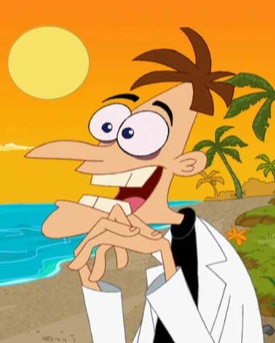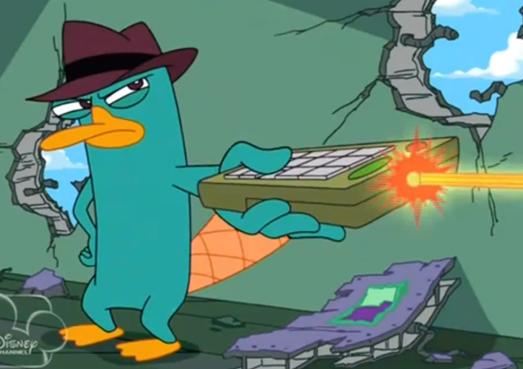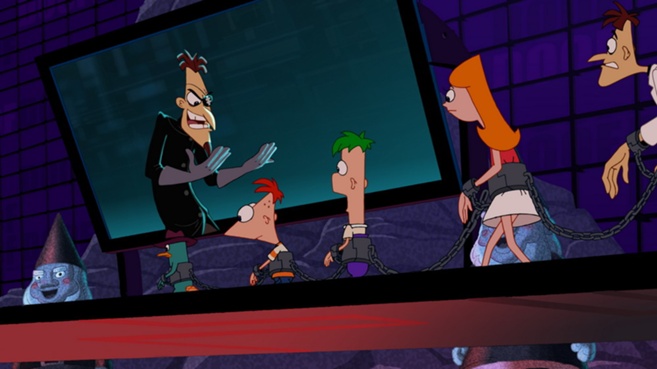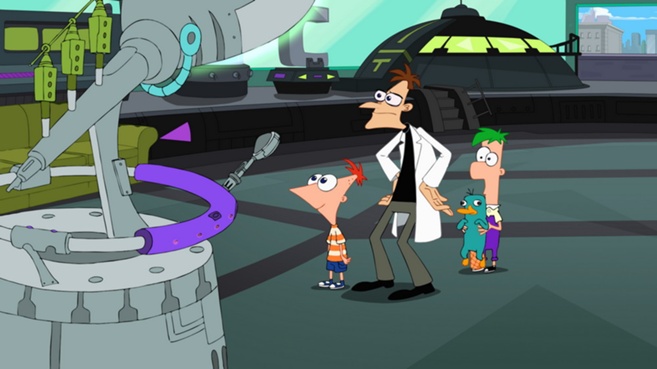I know that’s a strong claim for children’s cartoon on the Disney Channel. But seriously, the show about two brothers who spend each day having an insane adventure, their sister Candace, who spends each day trying to bust them, and their pet platypus Perry, who spends each day thwarting the mad schemes of the evil Dr. Doofenshmirtz, is one of the best depictions of science fiction on television today.
For one thing, outside of its spec fic premise, Phineas and Ferb is a really good show in general. I could write whole other articles on how it’s a blisteringly funny satire of contemporary pop culture, or how it’s a loving portrayal of a blended family that treats divorce and remarriage as normal parts of life, or how it’s remarkably cleverly written using repetition, variation, and song to create complex and compelling characters, or how the secret protagonist of the show is actually Candace, the teenager trapped between her desperate need to be an adult and her own childish desires to have fun.
All that aside, Phineas and Ferb is a great science fiction, by which I mean it uses an impossible world to tell real stories about real people. Beyond the individual episodes that focus on tropes of the sci fi genre (rockets, robots, time machines and shrink rays, for example), the whole show is, at its heart, about two mad scientists, Phineas Flynn* and Dr. Heinz Doofenshmirtz, who, though unaware of each other, are rivals in their quests to reshape the city of Danville and the entire Tri-State Area (named after John P. Tristate).
*Ferb Fletcher, Phineas’s brother, is a brilliant scientist in his own right, but since he rarely speaks or acts independently, he usually fills the role of Igor, as he explicitly does in the episode “the Monster of Phineas-n-Ferbenstein.”


That Phineas and Doofenshmirtz are two sides of the same triangle headed coin is the subtext of every episode, and the actual text of episodes like “I Scream, You Scream,” where they accidentally switch blueprints, and “Hail Doofania,” where they switch dialogue. Young Phineas is absolutely the better scientist, and just as mad. His solution to almost every problem is to build something impossible, usually before lunch. Even his lemonade stand is powered by a giant anthropomorphic robot. Doofenshmirtz, on the other hand, is no slouch in the building impossible devices department. He’s mainly hindered by his insistence that each device end in “-inator”, including his “Age Accelerator…-inator,” and that his plans are constantly foiled by a, well, “suave, semi-aquatic personification of unstoppable dynamic fury.”

The real difference then between the two is not what they can do, which is anything, but what they choose to do with almost unlimited power. Phineas is an altruistic epicurean on a quest to have the best summer ever. He doesn’t just want to ride a rollercoaster, he wants to ride the best rollercoaster, and if he has to build it himself (with the aid of his brother and friends), he will. But not just for himself. He wants everyone to have the best summer ever, whether that means inviting his friends along on his adventures or transforming Danville into a cooler place for everyone or gearing his adventures towards solving one of his friends specific problems. And I do mean he wants to help everyone, including Candace, against whom he holds no grudge for her constant attempts at busting him. Of course, that also leads to Phineas’s main flaw: he doesn’t always notice when his help is unwanted or its over the top nature causes more harm than good, like the giant tilt-a-whirl speed dating machine he builds for Candace, or the army of potato gremlins he accidentally unleashes trying to make latkes. But his heart is always in the right place, when he causes problems he makes sure to fix them, and even when his inventions fail, he laughs it off and looks forward to his next crazy plan.
Doofenshmirtz, on the other hand, is whatever the opposite of an altruistic epicurean is. A mean-spirited megalomaniac. Most of Doofenshmirtz’s schemes are aimed at taking over the entire Tri-State area, when they are not designed to revenge himself for some petty, possibly imagined slight. Not that he didn’t have a miserable childhood growing up in the country of Gimmelshtump—for example, his family could not afford a lawn gnome so he had to stand in the garden each night wearing a pointed hat and fake beard—but that’s no reason to vacuum away everybody else’s lawn gnome. His solutions always involve making everybody else’s life worse, rather than make his own life better. Rather than make himself more attractive, he creates a ray to make everyone else uglier. As focused as he is on the failures in his life, ignoring his amazing ex-wife and kick ass daughter, no wonder he’s miserable and spends each afternoon getting beaten up by a monotreme.

And while some episodes show how Phineas and Doofenshmirtz aren’t that different, other episodes, very science fiction-y episodes, demonstrate just how important their differences are and how horrible it would be if Doofenshmitz ever, you know, won. One great strength of science fiction is the ability to tell stories that are not just impossible generally, but would also ruin the ongoing narrative. But with alternate dimensions (in the TV movie Phineas and Ferb: Across the 2nd Dimension) and time travel (“Phineas and Ferb’s Quantum Booglaloo”), we see that a world ruled by Doofenshmirtz would be a colorless place where everyone wears the same clothes and children spend the summer indoors while hoping nothing bad happens to them. The two episodes also make it clear that, whether they know it or not, it is actually Phineas and Ferb, and the children they inspire, that keep the world from slipping into Doofensmirtz’s hands.
The point is clear, mad science aimed at hurting people creates a grey world where everyone looks the same and no one has fun. Helping others creates a colorful world full of intelligent people able to rise to any challenge. Phineas and Ferb has heroes using science at its best, and villains using it at its worst, and the show uses science fiction to tell inspiring stories about imagination. It’s a fantastic show everybody should be watching, and in closing, there’s a platypus controlling me.
Steven Padnick is a comics editor. By day.










